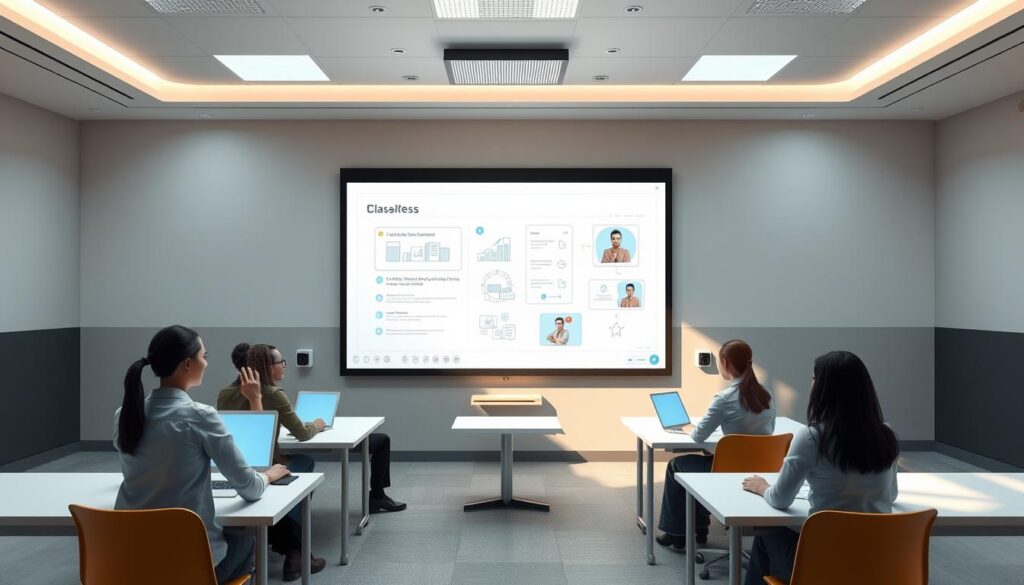As an experienced SEO copywriter, I’ll share practical tips to integrate remote learning tech for business success.
Remote Learning Technology
Can remote learning technology really change how we learn and work? With digital tools and virtual collaboration, it’s now key in business education. I’ll look at the good and bad sides of remote learning technology. It can make learning better for employees with the right tools.
Recent stats show 70% of students like remote learning for its flexibility. It lets them learn at their own speed with digital resources. This shift has also brought more students to schools, with 60% seeing more students. I’ll show how remote learning technology supports flexible learning for everyone.

Introduction to Remote Learning
Remote learning technology is vital for businesses, saving money and making learning easier. It’s helped 50% of schools save on costs. Also, 75% of teachers say multimedia in remote learning makes lessons better and students understand more. This makes it great for businesses wanting to improve training with online tools and virtual classrooms.
Key Takeaways
- Remote learning technology can enhance employee assessment, access, and learning experiences
- 70% of students prefer remote learning due to its flexibility and convenience
- 60% of educational institutions have experienced increased enrollment opportunities
- Remote learning technology can support flexible learning options, enabling remote, hybrid, or asynchronous access
- 75% of instructors have found that using multimedia resources in remote learning improves lesson effectiveness and student understanding
- Remote learning technology can have a positive impact on the bottom line, with 50% of educational institutes reporting significant cost savings
- Remote learning technology can be used in conjunction with digital learning resources to create a complete learning experience
Understanding Remote Learning Technology in Today’s Business Landscape
Remote learning technology is key for businesses today. It lets them offer flexible learning for employees. With online systems and platforms, companies can provide many training options. These options meet different learning needs and styles.
The use of remote learning tech is growing fast. The global e-learning market is expected to hit $375 billion by 2026. This rise is due to the need for easy learning solutions and staying competitive. Studies show 70% of students like the flexibility of remote learning. Also, 65% of schools have seen more students because of online learning.
Remote learning tech has many benefits for businesses. It boosts employee engagement, makes learning easier, and saves money. It also allows for personalized learning, which can improve job skills. For example, 75% of students do better with learning plans based on their performance.
Essential Tools and Infrastructure Requirements
Exploring remote learning, I see how vital the right tools and infrastructure are. Virtual classroom solutions, remote learning hardware kits, and online learning tools are key. They help make learning engaging and interactive. A well-equipped virtual classroom greatly impacts student success.
For remote learning, you need reliable internet, advanced networking gear, and strong cybersecurity. With more students learning online, schools must upgrade their IT. This includes tools for remote monitoring, cloud computing, and disaster recovery plans. These help keep education running smoothly.

To make remote learning smooth, the right hardware and software are needed. Remote learning hardware kits give students the tools for online classes. Online learning tools make learning interactive and fun. By investing in these, schools can create a great remote learning space for everyone.
Selecting the Right Remote Learning Technology Platform
Exploring remote learning, I see how vital it is to pick the right online education platform for my business. There are many choices, so I must figure out what I need and compare features. The vast world of online learning technology demands a platform that matches my business goals.
When looking at remote teaching software, I think about scalability, user experience, and how well it fits with my current systems. A good platform should make communication easy, offer interactive tools, and have easy-to-access resources. The right technology can boost employee engagement, help them remember what they learn, and make them more productive.
Some important features to look for in a platform include:
- Customizable learning paths
- Real-time feedback and assessment tools
- Collaboration and discussion forums
- Mobile accessibility and offline access
By carefully looking at these features and my business needs, I can pick a platform that helps my remote learning efforts succeed.
Choosing the right remote learning technology platform needs careful thought and research. By focusing on my business needs and comparing features, I can create a learning experience that motivates my team. This will help my business grow and succeed.
Creating an Effective Implementation Strategy
Exploring remote learning, I see how vital a good plan is. It must meet the needs of all involved. This way, businesses can smoothly adopt and use remote learning tech.
Keeping up with new tech trends is key. Businesses should look into online platforms that are flexible and easy to use. This helps employees succeed in remote learning.

For a solid plan, businesses need to be consistent and talk a lot with everyone. They should set clear goals and share updates often. This helps avoid confusion and makes the switch to remote learning easier.
Important parts of a good plan include:
- Creating new routines and connections
- Focus on the most important skills and standards
- Use feedback to keep improving
By thinking about these points, businesses can do well in remote learning.
Training Your Team for Remote Learning Success
To make sure your team uses remote teaching tools well, training is key. You need to teach them technical skills, create user guides, and set up support systems. With online learning systems, teams can learn how to use virtual environments.
Here are some ways to train your team effectively:
- Provide interactive and engaging training sessions for different learning styles.
- Offer self-paced learning options to fit various work schedules.
- Use behavioral analytics and feedback to track and improve training.
Investing in remote training boosts learning, cuts down on turnover, and fosters growth. The remote training market is expected to hit nearly $27 billion by 2027. By using online systems and virtual environments, businesses can equip their teams for remote success.
Measuring Remote Learning Effectiveness
Exploring remote learning, I focus on how to measure its success. With more students learning online, it’s key to use data to see its impact. Remote learning analytics help us understand how students interact with online materials.
By tracking these metrics, teachers can spot what needs work and improve their teaching. Virtual learning assessment is also important. It lets teachers check how well students are doing and give them feedback.
Using analytics and metrics, teachers can make their lessons better. For example, a study showed that using data can boost student success by up to 15%.
Some important things to measure include:
- Student engagement and participation rates
- Completion rates and course progress
- Learner satisfaction and feedback
Tracking these helps teachers see how well their online programs are working. They can then make changes based on the data.
By using analytics and metrics, teachers can make learning more effective and fun for students. As we keep exploring remote learning, it’s vital to focus on measuring its success and using data to get better.
Overcoming Common Remote Learning Challenges
Remote learning comes with its own set of challenges. Technical issues and communication barriers are just a few. But, with the right strategies, we can overcome these hurdles and make learning smooth.
Online learning obstacles include technical problems, lack of engagement, and communication issues. To tackle these, having a support system is key. Also, clear instructions and active communication with teachers are vital.
Here are some ways to beat remote learning challenges:
- Provide detailed instructions on accessing training and asking questions
- Encourage active communication with instructors
- Use tools like Learning Management Systems (LMS) with calendar functions to streamline scheduling and organization
- Have a backup plan for technical issues, such as access to a public library or a hotspot
By using these strategies, we can tackle common remote learning challenges. This creates a supportive learning space that boosts engagement and satisfaction. Remote learning can be very effective, and I’m eager to find more solutions.
Integrating Remote Learning with Existing Business Processes
Exploring remote learning integration, I focus on how businesses can blend it with their current systems. The success of this integration depends on understanding the business’s specific needs and goals. This way, companies can develop a remote learning strategy that fits their existing setup.
Remote learning is key for businesses to keep up in today’s digital world. It allows companies to offer flexible learning options to their employees. This makes virtual learning solutions a must-have for businesses to train and develop their teams effectively.
Some benefits of remote learning integration include:
- Increased flexibility and accessibility
- Improved employee engagement and retention
- Enhanced collaboration and communication
- Reduced costs and increased ROI
By adopting remote learning, businesses can build a more adaptable workforce. The right online learning strategy can boost growth, productivity, and competitiveness. As we move forward in the remote learning space, focusing on solutions that fit each business’s unique needs is vital.
Security and Privacy Considerations in Remote Learning
Exploring remote learning, I see how vital security and privacy are. With more virtual learning, protecting sensitive info is key.
Recent stats show 70% of remote learning platforms didn’t meet privacy rules in 2023. This shows the need for strong data protection and following rules.
Important security points for remote learning include:
- Regular risk checks to find weak spots
- Strong data encryption to keep info safe
- Following rules like the Family Educational Rights and Privacy Act (FERPA)
By focusing on security and privacy, we make learning online safe for everyone. This protects students’ info and helps make learning online better.
Scaling Your Remote Learning Initiative
Exploring remote learning shows its need for growth to succeed. Businesses must plan for growth, manage resources, and improve performance. This ensures their remote learning can meet changing learner needs.
Scaling remote learning means focusing on several key areas. These include investing in technology, supporting educators, and improving the learning experience. By focusing on these, businesses can build a scalable and effective remote learning program.
Growth Strategies
Businesses should aim to grow their online and virtual learning. This can be done by reaching new markets, creating new courses, and using social media to promote. These steps help expand their reach and offerings.
Resource Allocation
Getting the right resources is key to remote learning success. Businesses should invest in technology, hire skilled educators, and offer ongoing support. This ensures learners have what they need to succeed.
Performance Optimization
Improving performance is essential. Businesses should track metrics like learner engagement and satisfaction. This data helps improve the learning experience for everyone.
By implementing these strategies, businesses can create a scalable and effective remote learning program. This program meets learner needs and drives growth in online and virtual learning.
| Strategy | Description |
|---|---|
| Growth Strategies | Expand reach to new markets, develop new courses and programs, leverage social media and digital channels |
| Resource Allocation | Invest in right technology, hire and train qualified educators, provide ongoing support and resources |
| Performance Optimization | Continually evaluate and improve remote learning initiatives, track key metrics, inform improvements to learning experience |
Embracing the Future of Business Education
Looking ahead, remote learning tech will be key in business education. The pandemic sped up the use of online learning and virtual classrooms. Schools like Stanford University are now focusing on using these tools to improve education.
Remote learning is great for students in executive MBA programs. They can learn while working full-time. At UC Berkeley’s Haas School of Business, smaller classes are preferred for better learning.
Business schools need to keep up with what students want. The pandemic made people care more about making a difference. Schools must teach students to tackle today’s big challenges.
By using , , and , schools can stay ahead. They need to mix remote learning with face-to-face teaching. This mix will help business education succeed globally.
FAQ
What are the key components of remote learning systems?
Remote learning systems have online learning management systems, e-learning tools, and distance learning platforms. These tools help businesses offer interactive learning experiences. This is true no matter where employees are located.
What are the benefits of remote learning technology for modern businesses?
Remote learning technology brings many benefits to businesses. It improves employee assessment and gives more access to learning resources. It also makes learning more engaging and helps businesses stay up-to-date with education trends.
What are the current market trends and adoption rates for remote learning technology?
The demand for remote learning solutions is growing. Businesses see the value of digital tools and virtual collaboration in education. More businesses are adopting remote learning technology to offer flexible learning opportunities.
What are the essential tools and infrastructure requirements for implementing remote learning?
To implement remote learning, businesses need the right tools and infrastructure. This includes virtual classroom solutions, remote learning hardware kits, and online learning tools. Businesses must have the technical capabilities and resources for an effective remote learning experience.
How can businesses select the right remote learning technology platform?
Choosing the right remote learning technology platform involves several steps. Businesses need to assess their needs, compare platform features, and consider budget and ROI. The chosen platform should meet their specific requirements and provide a seamless learning experience.
How can businesses create an effective implementation strategy for remote learning technology?
Creating a tailored implementation strategy is key for remote learning success. Businesses must evaluate their unique objectives and requirements. They should plan for a smooth transition and aim for maximum ROI.
How can businesses train their teams for remote learning success?
Training teams for remote learning success requires several steps. Businesses need to develop technical competencies, create user guidelines, and establish support systems. This ensures teams have the skills and knowledge to use remote learning technology effectively.
How can businesses measure the effectiveness of their remote learning initiatives?
Measuring remote learning effectiveness is vital for businesses. They can use data and analytics to assess engagement, completion rates, and learner satisfaction. This helps make informed decisions and understand the impact of remote learning.
What are the common challenges faced by businesses when implementing remote learning technology?
Businesses face several challenges when implementing remote learning technology. These include technical issues, engagement challenges, and communication barriers. Having a support system in place helps learners overcome these challenges and ensures successful adoption.
How can businesses integrate remote learning with their existing business processes?
Integrating remote learning with existing processes is essential for success. Businesses should assess their unique requirements and objectives. They should ensure the remote learning technology aligns with their systems and processes.
What are the security and privacy considerations for remote learning?
Security and privacy are critical for remote learning. Businesses must implement data protection measures and comply with regulations. They should follow best security practices to protect sensitive information and learner privacy.
How can businesses scale their remote learning initiatives?
Scaling remote learning initiatives requires strategic planning. Businesses need to develop growth strategies, allocate resources effectively, and optimize performance. They should have a plan to manage and expand their programs as needed.
Source Links
- https://www.splashtop.com/blog/what-is-remote-learning?srsltid=AfmBOorTUKrRmWTpHKKQmK5T_AVhB6xfTvwfuiDi8o1kz475n_AnrYYA
- https://trainingindustry.com/articles/remote-learning/using-technology-to-create-engaging-remote-learning-experiences/
- https://www.turnitin.com/blog/understanding-educational-technology-and-its-impact-on-the-learning-landscape
- https://www.splashtop.com/blog/what-is-remote-learning?srsltid=AfmBOoqkH7n-HNjxABKorbU3QYqlsb2TCZsJ7iLIXuO1ZzUbPNXyyFoy
- https://www.worldbank.org/en/topic/edutech/brief/how-countries-are-using-edtech-to-support-remote-learning-during-the-covid-19-pandemic
- https://edtechmagazine.com/k12/article/2020/09/3-steps-optimize-your-it-infrastructure-remote-learning
- https://www.technologylab.com/building-a-resilient-it-infrastructure-for-k-12-schools/
- https://www.worldbank.org/en/topic/edutech/brief/edtech-toolkit-for-remote-learning
- https://pce.sandiego.edu/14-online-teaching-tools-technology-for-remote-learning-faqs/
- https://www.gettingsmart.com/2020/03/29/choosing-the-right-tools-for-remote-learning/
- https://www.dyknow.com/blog/6-steps-to-implement-remote-learning/
- https://www.watermarkinsights.com/resources/blog/the-four-crucial-steps-to-ensure-a-successful-technology-implementation/
- https://learningaccelerator.org/3-steps-to-building-an-effective-remote-learning-experience/
- https://whatfix.com/blog/remote-training-best-practices/
- https://www.insperity.com/blog/continuing-education-for-remote-workers/
- https://pmc.ncbi.nlm.nih.gov/articles/PMC10266495/
- https://www.apa.org/monitor/2021/09/cover-remote-learning
- https://online.uc.edu/blog/common-distance-learning-challenges/
- https://trainingindustry.com/articles/remote-learning/5-remote-learning-challenges-and-how-to-overcome-them/
- https://www.mckinsey.com/capabilities/operations/our-insights/everyone-is-within-learning-distance-building-skills-remotely
- https://www2.deloitte.com/us/en/insights/industry/telecommunications/connectivity-mobile-trends-survey/2023/adoption-of-technology-integration-in-education.html
- https://www.bie.edu/topic-page/policy-considerations-pivoting-remote-learning
- https://www.ue.org/risk-management/enterprise-risk-management/protecting-student-data-privacy-in-a-remote-learning-environment/
- https://www.cois.org/about-cis/perspectives-blog/blog-post/~board/perspectives-blog/post/data-protection-and-privacy-implications-of-online-and-remote-learning
- https://www.vassonline.org/component/zoo/item/how-to-develop-scalable-remote-learning-plans
- https://www.mckinsey.com/industries/education/our-insights/getting-the-next-phase-of-remote-learning-right-in-higher-education
- https://news.stanford.edu/stories/2020/10/future-business-education-must-also-greater-good
- https://www.colorado.edu/business/news/commentary/2020/10/27/2020-the-remaking-of-business-education-post-covid-19
Discover more at:
TrendNovaWorld | Zyntra | Flair Trend Nova World| The Planet Digest| Expert Opinion|Global Fusion
Find More: Vorelia Flair Articles

Saiqa Khan is an award-winning researcher with 16+ years of experience in AI, technology, finance, health, sustainability, and digital marketing. With dual master’s degrees, she delivers expert, research-driven insights across multiple fields.


